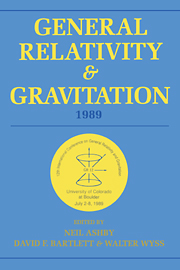 General Relativity and Gravitation, 1989
General Relativity and Gravitation, 1989 Book contents
- Frontmatter
- Contents
- Preface
- Conference committees
- Part A Classical relativity and gravitation theory
- WORKSHOPS
- Part B Relativistic astrophysics, early universe, and classical cosmology
- WORKSHOPS
- Part C Experimental gravitation and gravitational wave detection
- WORKSHOPS
- Part D Quantum gravity, superstrings, quantum cosmology
- 14 Self-duality, quantum gravity, Wilson loops and all that
- 15 Progress in quantum cosmology
- 16 String theory as a quantum theory of gravity
- WORKSHOPS
- Part E Overviews-past, present, and future
16 - String theory as a quantum theory of gravity
Published online by Cambridge University Press: 05 March 2012
- Frontmatter
- Contents
- Preface
- Conference committees
- Part A Classical relativity and gravitation theory
- WORKSHOPS
- Part B Relativistic astrophysics, early universe, and classical cosmology
- WORKSHOPS
- Part C Experimental gravitation and gravitational wave detection
- WORKSHOPS
- Part D Quantum gravity, superstrings, quantum cosmology
- 14 Self-duality, quantum gravity, Wilson loops and all that
- 15 Progress in quantum cosmology
- 16 String theory as a quantum theory of gravity
- WORKSHOPS
- Part E Overviews-past, present, and future
Summary
Introduction
Although the roots of string theory go back to the late 1960's, the first connection between string theory and gravity was noticed in 1974 independently by Yoneya (1974) and by Scherk and Schwarz (1974). By the early 1980's it became clear that the recently developed superstring theory was an excellent candidate for our first perturbatively finite quantum theory of gravity. One loop calculations were shown to be finite and general arguments suggested that this should hold to all orders. (For a review of what was known at that time see Schwarz (1982).) Since then, an enormous amount of work has been done and progress made in our understanding of string perturbation theory. The evidence for finiteness has grown stronger and stronger (see e.g. D'Hoker and Phong (1988); Atick, Moore and Sen (1988); La and Nelson (1989), and references therein). Although there is always a chance of some unexpected results, no one who works on this subject doubts that it is true.
Conspicuously absent from this brief history is the remarkable explosion of interest in string theory beginning in the fall of 1984 and the almost equally remarkable drop in interest in the past year or so. This mood swing had nothing to do with string theory providing a consistent quantum theory of gravity. Rather, it resulted from the hope that the “uniqueness” of string theory would lead to definite low energy predictions in a simple way. Unfortunately, this hope has not been fulfilled.
- Type
- Chapter
- Information
- General Relativity and Gravitation, 1989Proceedings of the 12th International Conference on General Relativity and Gravitation, pp. 419 - 440Publisher: Cambridge University PressPrint publication year: 1990
- 1
- Cited by
